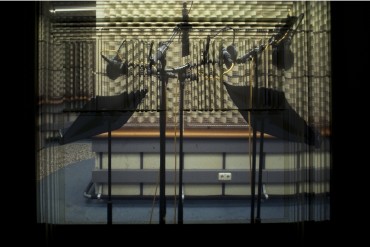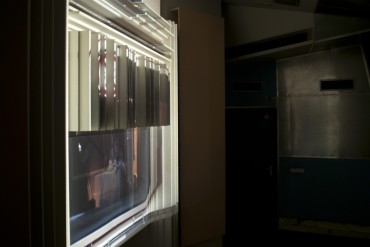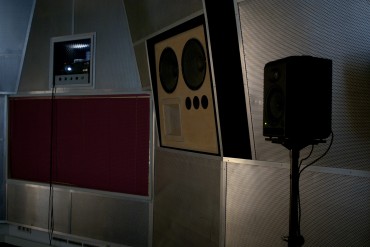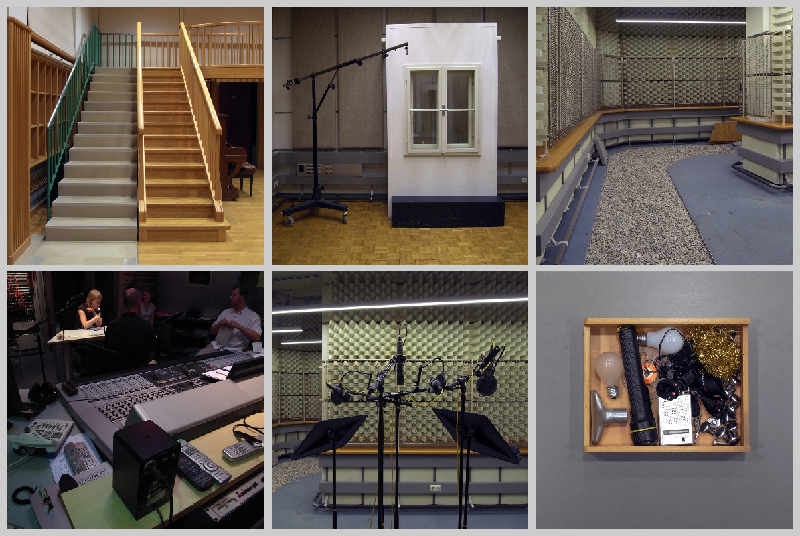“Radio Plays Itself”
by Raviv Ganchrow
 PLAY
PLAY
A
COPY OF THIS PROGRAM CAN
BE ORDERED FROM THE "ORF
TONBANDDIENST"
| Radio Plays Itself takes the site of the ORF (Austrian Broadcasting) Hörspiel studio, at Funkhaus Vienna, as the starting point for a radio play exploring the studio's spaces and devices as sonic entities in their own right. Specialized recordings conducted over the course of one week at ORF's RP4 Hörspiel studios, in combination with excerpts from archive material produced at the same facility, provide resources for a play-on-radio where ambience becomes protagonist. Going beyond an exposé of the studio sound effects, the piece journeys into radiophonic space, focussing on a productive tension arising between sound's extrinsic meanings and its own internal modes of vibration. Formatted as a play in nine acts, this piece seeks moments where signals oscillate back and forth between spatial-material presence, social referentiality and physical vibrancy. With its roots in radio's golden age, the Hörspiel (radio play) is a technology-specific genre dedicated to the production of in-situ, primarily narrative based, audio dramas. The Hörspiel production studio, often housed in larger broadcasting stations, could be considered as a dedicated radiophonic device for the production of audible 'place'. Unique in its spatial layout, the Hörspiel studio is set up as an elaborate sound prop designed to generate and stage live ambient backdrops able to convey distinctive qualities of audible location. In stark contrast, a typical radio announcer's studio employs stringent sound absorption and acoustic isolation codes that intentionally tune out the surrounding ambiences at the station. Application of acoustic isolation and abortion is central in creating a signature 'radio voice' where narration seemingly hovers above, or from beyond, the audible spaces in radio programming. From early on the radio play was a site for audio experimentation. The perceptual shifting capacities of Hörspiel's acousmatic event-space prompted an exploration of technically driven narrative structures, spatial-temporal manipulations and innovative methods of sound production. Nowhere are these aspects more apparent than in the category of the experimental Hörspiel or new radio drama that blurs distinctions between narrative, reportage, sound and music. Generally speaking, the Hörspiel's distinct exploration of the technical affordances of wireless along with its marked consciousness of the listening conditions pertaining to household radio receivers, sets this genre apart from other formats of broadcast in its attempt at establishing radio as an artistic medium in its own right. Considered on this backdrop, the radio play in general, and the Hörspiel studio in particular, abounds with contextual significance. Every radio play studio along with its collective contents is telling of the period, locale, material history and more generally an auditory awareness in which it is invested. From the designation of room types to the particular choices of sounding objects, the Hörspiel studio could be said to encapsulate an aural vernacular spanning listening traditions, geographical regions, and historically bound techniques of sound production. Arguably such resounding context does not terminate at the studio's physical boundaries but rather continues to accumulate along sound's path of transduction. Once sounds are converted into signals they propagate through the circuitry of editing and transmission where they further modulate with diverse electrical frequencies and auditory mind-sets. It is towards this cacophony of contexts, and the conditions of auditory awareness such contextual instances manifest, that Radio Plays Itself lends an ear. Systematic recordings of the objects and chambers at the RP4 Hörspiel studio complex, interlaced with archival material and reworked through customized editing techniques aim at bringing out diverse aspects of the devices, methods and formats of the radio play setting. Tuning into RP4's inbuilt murmurs and wading through the labyrinth of broadcast sound reveals a place where voices of audio technique become enmeshed with the sonority of spaces and things. By directing broadcast at its own signals and providing more air-time for radio's ether, this piece sounds-out radiophonic production itself. This role reversal foregrounds the 'ambient' in radio not as an 'effect' but rather as a complex contextual agent instrumental in shaping certain modes of listening. Radio Plays Itself was realized in collaboration with ORF Kunstradio and was partially made possible with support from the Mondriaan Fonds NL, and the University of the Arts, The Hague, NL.     Fotos: Lucas Norer |

PROGRAM
CALENDAR
CALENDAR
